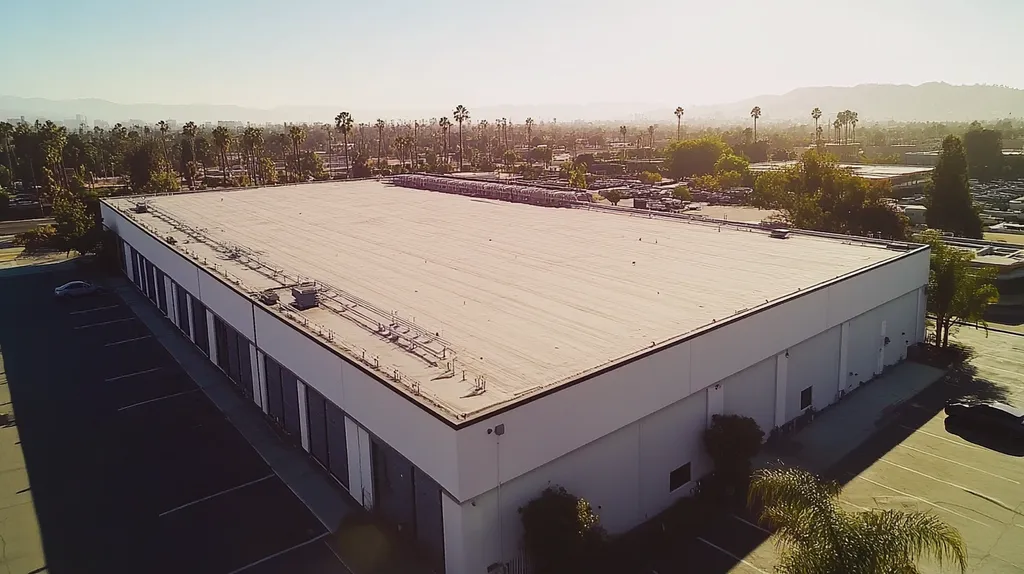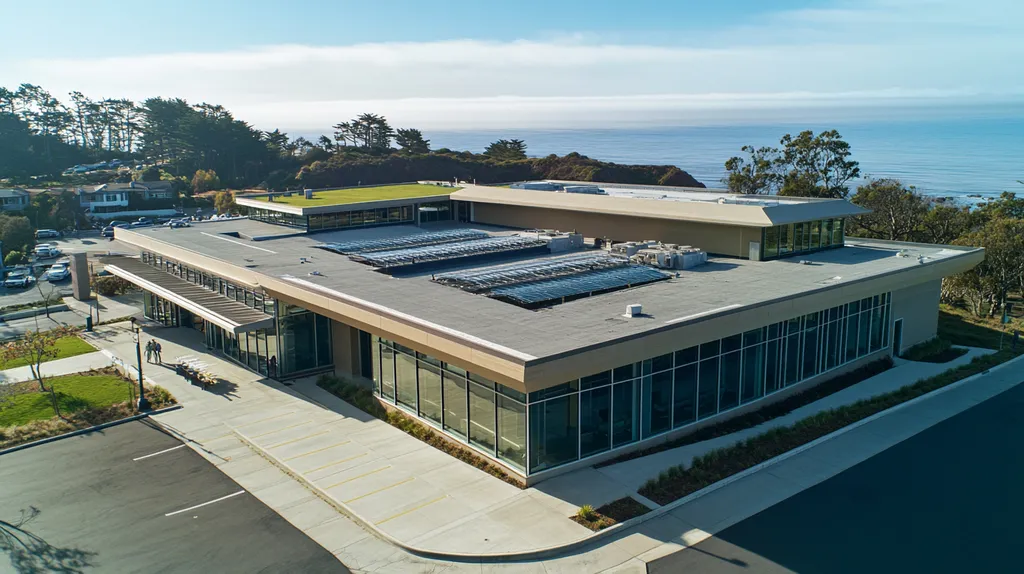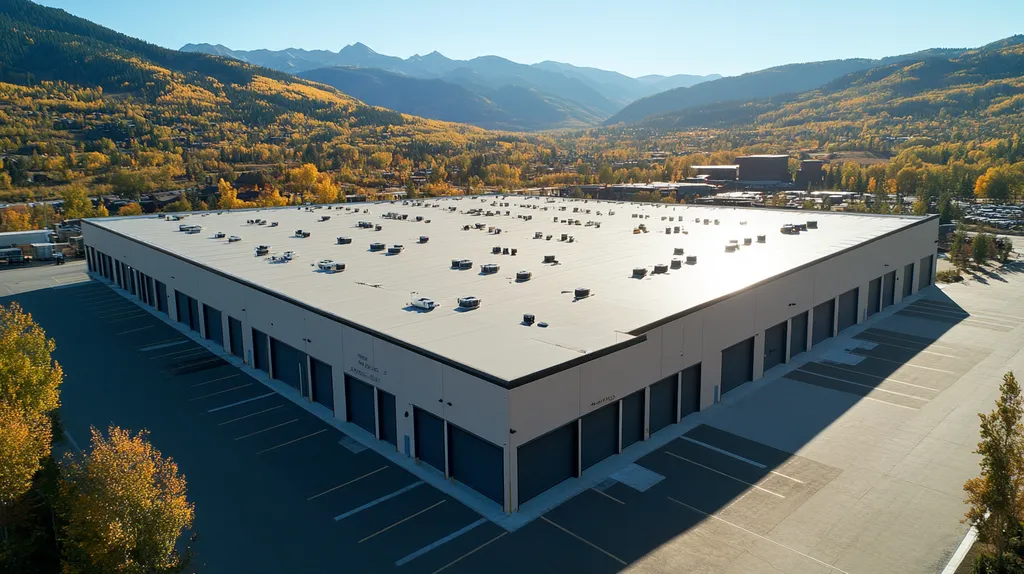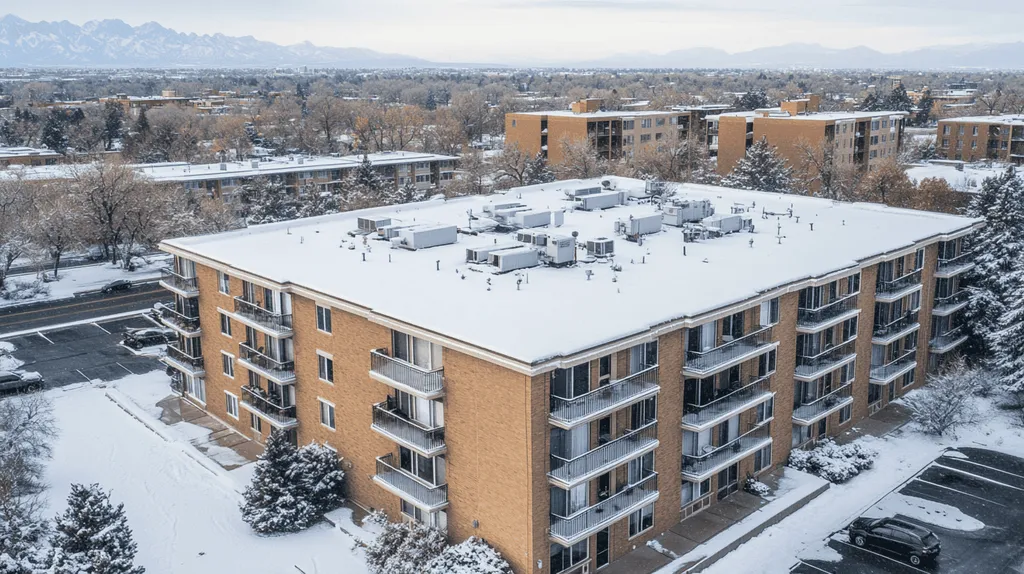For commercial property owners, understanding reflective coating warranties has become a critical financial imperative, with studies showing that warranty-related oversights cost facilities an average of $2.40 per square foot in premature repairs.
As energy costs continue to rise, these specialized coatings can reduce cooling expenses by up to 30% while extending roof lifespan by decades – but only when properly protected by comprehensive warranty coverage.
This guide examines the essential components of reflective coating warranties, from coverage terms to maintenance requirements, equipping property owners with the knowledge to maximize their roofing investments.
SECTION 1: THE BASICS EXPLAINED
Understanding warranties for reflective coatings on commercial roofs is crucial for building owners. With energy costs on the rise and increasing environmental concerns, an effective roof coating can substantially reduce heat absorption. Unfortunately, many facilities managers overlook the intricacies of these warranties, exposing themselves to the risk of expensive repairs and inefficiencies. This section breaks down the essential elements of reflective coatings, highlights their significance for building performance, and explains their operational mechanics.
What It Is (In Plain Language)
Reflective coatings are specialized materials that are applied directly to a roof’s surface to reflect sunlight. By bouncing away solar heat, these coatings help to keep buildings cooler, particularly during sweltering months. The result is lower energy consumption, which translates into reduced utility bills.
Beyond energy savings, these coatings also extend the lifespan of the roof by mitigating damage caused by heat exposure. Although they may appear to be a simple addition, the benefits for energy efficiency and longevity are substantial.
Warranties associated with these coatings offer protection against potential failures, assuring property owners of the coating’s reliability. It is essential to grasp the warranty’s specifics to fully maximize its advantages.
Many warranties outline critical terms such as the expected lifespan, maintenance obligations, and the conditions under which the warranty remains valid. Therefore, a thorough understanding of the warranty details is indispensable.
Why It Matters (To Your Building)
The benefits of reflective coatings extend far beyond mere appearance. By installing these coatings, property owners can achieve significant reductions in energy bills, with many buildings reporting 10-30% savings on cooling expenses.
In addition to financial advantages, energy-efficient roofing aligns with broader sustainability goals. This not only boosts the building’s market value but also helps owners comply with environmental regulations.
Warranties are vital for safeguarding these investments. They can dictate how much building owners might pay out-of-pocket for necessary repairs or replacements in the future.
Without a comprehensive warranty, owners may face unexpected costs should the coating fail prematurely, resulting in financial strain and operational disruptions.
How It Works
Reflective coatings operate based on thermal reflection principles. These coatings are engineered to redirect sunlight, thereby minimizing heat accumulation on roofs. This technology is particularly effective for flat or low-slope roofs.
Once applied, the coating forms a protective barrier against harmful UV rays, which can degrade roofing materials over time. Furthermore, it helps reduce the ‘urban heat island’ effect, positively influencing local climate conditions.
Warranties often cover factors such as adhesion failure, color fading, and overall performance. This means that if the coating doesn’t perform as promised, the manufacturer will provide necessary repairs, replacements, or even refunds.
To take full advantage of these warranties, property owners must ensure proper application and adherence to maintenance guidelines. Consistent inspections can help maintain roof integrity, ensuring that warranties remain valid.
SECTION 2: PRACTICAL APPLICATIONS
The implementation of reflective coatings on commercial roofs is more than a cosmetic enhancement; it plays a pivotal role in reducing energy expenditures and prolonging roof lifespan. In hot climates, these coatings can cut cooling costs by up to 30%. With rising energy prices, it’s essential for property owners and facility managers to identify when and where to utilize these coatings strategically. This section examines common applications, optimal timing for installation, and the integration of reflective coatings with other roofing systems.
Common Uses & Examples
Reflective coatings are primarily applied to flat and low-slope roofs in commercial structures, especially in urban environments where temperatures can soar due to the heat island effect. For instance, a retail warehouse treated with reflective coatings can maintain more stable internal temperatures during peak summer, enhancing comfort for staff and customers alike.
These coatings don’t just improve energy efficiency; they also protect roofing materials from damage caused by UV rays and thermal shock, helping to extend the roof’s lifespan. Facilities like warehouses, schools, and hospitals particularly benefit, as effective climate control is essential for their operations.
Moreover, reflective coatings offer an opportunity to elevate a building’s aesthetic appeal. By selecting various colors and finishes, property owners can align the visual identity of their structures with energy-saving advantages. Thus, applying reflective coatings serves the dual function of beautifying and enhancing functionality.
When You Need It Most
Optimal timing for applying reflective coatings is critical, ideally before the hottest months of the year—during spring or early summer. Applications made in cooler conditions risk improper curing, which could reduce the coating’s efficacy. Buildings located in warmer regions stand to gain significantly, as these coatings reflect sunlight and substantially lower roof temperatures.
Applying reflective coatings is particularly beneficial during roof upgrades or replacements. Incorporating these coatings into routine maintenance schedules not only enhances roof durability but also mitigates leak risks. Without the protection of reflective coatings, building owners may face elevated energy consumption and rising maintenance costs.
Understanding the peak demand for cooling is also pivotal. When reflective coatings are in place before summer, property owners can take advantage of lower energy rates and improve the comfort of tenants. In many areas, the timing of the application could mean the difference between sky-high and manageable energy expenses.
Interactions With Other Systems
The successful implementation of reflective coatings requires careful consideration of existing roofing systems to ensure optimal performance. For example, when paired with insulated roofing systems, reflective coatings can significantly bolster overall energy efficiency. However, improper application on incompatible surfaces risks issues like blistering and peeling.
Close attention must be given to drainage systems as well. A smooth, reflective surface can help prevent water accumulation, but proper slope must be maintained for effective drainage. Neglecting these factors can result in premature failure of the coating and unforeseen repair expenses.
Additionally, adding layers of reflective coatings to roofs with existing structural insulation requires a careful assessment of the combined weight. Consulting with a roofing professional is crucial to ensure the building can accommodate these additional layers and remain within warranty parameters for all integrated systems.
SECTION 3: KEY TERMINOLOGY DECODED
Grasping the key terminology surrounding warranties for reflective coatings is fundamental for property owners. Misunderstandings or a lack of clarity can quickly lead to costly decisions. Familiarity with critical terms not only influences material choices but also shapes maintenance expectations. By learning this essential vocabulary, building owners can better advocate for their interests during warranty negotiations and ensure informed investments in their roofing solutions.
Essential Terms Explained
Warranties typically encompass terms like “material warranty” and “workmanship warranty.” A material warranty guards against defects in the roofing materials, confirming the reliability of the reflective coating. Depending on the manufacturer, this warranty can span from 5 to 30 years.
Conversely, a workmanship warranty pertains to the quality of the installation. It protects property owners from complications arising from poor methods that might void the material warranty. Usually shorter in duration, this warranty lasts between 2 to 10 years.
Understanding these distinctions allows property owners to assess the protection their investment will receive. Each type of warranty serves a unique role, collectively creating a robust safety net for roofs.
Additionally, warranty coverage can often be enhanced through enterprise options, which may offer extra protections. Being aware of these options enables building owners to make decisions that effectively align with their long-term needs.
Industry Jargon Translated
Terms such as “reflectivity” and “emissivity” are essential for evaluating reflective coatings’ performance. Reflectivity measures how much sunlight a coating reflects away from the roof surface. Higher reflectivity translates to reduced heat absorption, positively affecting energy expenses.
In contrast, emissivity assesses how effectively the material releases heat back into the atmosphere. A lower emissivity indicates less heat loss, keeping rooftops cooler. Both properties significantly influence the roofing system’s longevity and energy efficiency.
Property owners should look for coatings that feature high reflectivity paired with low emissivity for optimal benefits. This balance leads to lower building temperatures and enhanced energy efficiency, which can cut down HVAC costs.
Clarifying these terms not only improves communication with roofing professionals but also empowers property owners to make more informed choices for long-term savings.
Measurement & Units Simplified
Familiarity with measurements related to reflective coatings simplifies product selection. The critical metrics include Solar Reflectance Index (SRI), reflectance percentage, and thermal emittance values. SRI combines both reflectivity and emissivity into a single index.
Reflectance percentage indicates how much solar energy is reflected. A recommended benchmark for maximum energy efficiency is a roof coating with at least 70% reflectance. Conversely, thermal emittance values, expressed as decimals, show how much heat the material emits back into the environment.
Being aware of these measurements allows property owners to evaluate products uniformly, a crucial aspect when comparing warranties that might include performance metrics.
Ultimately, understanding these foundational units assists property owners in making informed decisions about reflective coatings, ensuring the right fit for their specific requirements and a solid roofing investment.
SECTION 4: DECISION FACTORS
Choosing the right reflective coatings for commercial roofs is vital for ensuring long-term performance and financial viability. Research indicates that these coatings can reduce cooling costs by as much as 30%. Property owners face important decisions that revolve around cost, performance, and durability. By thoroughly evaluating these factors, stakeholders can make strategic choices that secure their investments and improve overall building management.
Cost Considerations
The initial investment for reflective coatings can vary significantly depending on the materials used and application methods. Although cheaper products can be enticing, they often lead to higher ongoing costs attributed to maintenance and increased energy consumption. By investing in high-quality coatings, property owners often experience greater long-term savings due to lower energy bills.
Warranties are an integral part of cost considerations as well. A robust warranty can cover repairs or replacements, alleviating the financial burden for property owners in the event of failure. Property managers should balance the risks associated with lower-cost products that may lack comprehensive warranties against the reliability of premium options.
Additionally, understanding the return on investment (ROI) is crucial. Reflective coatings that deliver notable energy savings and boast longer lifespans typically provide a better ROI than cheaper, short-lived alternatives. The long-term financial impact of energy consumption should be factored into any cost evaluation.
To conclude, property owners should adopt a holistic view of both upfront expenses and potential long-term savings when selecting reflective coatings. This approach is essential for making informed decisions that align with financial goals.
Performance Trade-offs
Performance is a critical aspect when choosing reflective coatings, as effectiveness can greatly vary among products. While some coatings may have a lower initial cost, their reflective properties can degrade quickly, leading to higher energy usage over time. Products with proven performance histories in energy efficiency are generally more dependable.
Moreover, different reflective coatings may respond variably to environmental factors. Certain coatings are engineered for superior UV resistance, while others might falter under extreme conditions. Property owners should consider their specific climate and roofing scenarios when selecting the most appropriate product.
It is essential to recognize that both the thickness of the coating and its application method can profoundly affect performance. Thicker coatings often provide enhanced durability and reflectivity, improving energy efficiency in the long run. However, these advantages may come at a higher upfront cost.
In summary, understanding the performance trade-offs of different reflective coatings is vital for making informed purchasing decisions. Each product must be assessed against the distinct requirements of the property.
Lifespan & Durability Factors
The lifespan of a reflective coating can dramatically influence its overall value. High-quality coatings have lifespans extending beyond 20 years, while cheaper counterparts may need replacement within half that time. This difference highlights the importance of evaluating long-term durability when selecting materials.
Another significant factor is how well coatings endure environmental stressors, like UV exposure and temperature fluctuations. Coatings that fail to perform adequately under these conditions may degrade prematurely, potentially impacting warranty coverage. Hence, property managers should choose products supported by solid durability testing.
The installation process is equally crucial in determining coating longevity. Adhering closely to manufacturer specifications during application ensures optimal performance throughout the coating’s lifespan. Neglecting proper application can lead to premature failures and unexpected financial losses.
Ultimately, property owners must assess the lifespan and durability of reflective coatings in conjunction with warranty details. Making well-informed choices here can ensure that selected products meet both immediate and long-term operational requirements.
SECTION 5: COMMON CHALLENGES
Maintaining and protecting reflective coatings on commercial roofs is critical for property owners seeking energy efficiency and longevity. However, challenges such as adhesion failure, surface degradation, and moisture infiltration can arise, leading to costly repairs and diminished performance. Understanding these common issues is essential for avoiding major setbacks and maximizing the investment in roof coatings.
Frequent Problems & Solutions
Poor adhesion of reflective coatings is a prevalent issue, often resulting from inadequate surface preparation before installation. To counter this, property owners should ensure that existing roofing surfaces are thoroughly cleaned and dried prior to coating application. Conducting a meticulous inspection post-installation can help identify any potential adhesion-related issues early on, allowing for timely intervention.
UV degradation is another common challenge. As coatings are exposed to sunlight, their reflective properties may deteriorate over time. To maintain optimal energy efficiency, property owners are advised to perform regular inspections and reapply the coating as needed, typically every few years.
Moisture infiltration can cause significant damage. When water penetrates beneath the coating, it can compromise the roof’s integrity and encourage mold growth. Regularly checking for visible signs like cracks or blisters in the coating can help property owners address these issues proactively, preventing extensive damage.
Environmental factors, particularly harsh weather conditions, can also pose risks. Selecting coatings engineered to withstand extreme environments can enhance the durability and performance of the reflective surface, ultimately protecting the underlying structure.
Warning Signs To Watch For
Vigilance is essential for property owners when monitoring the condition of reflective coatings. Discoloration or fading on the roof’s surface is a major red flag, indicating a decline in reflectivity that may lead to higher cooling costs if unchecked.
Cracking or blistering of the coating can point to deeper issues, often signaling moisture infiltration beneath the surface. Quick action is necessary to remedy these concerns and prevent further deterioration.
Puddles forming on the roof after rainfall are another warning sign, suggesting that the coating’s effectiveness has been compromised. If standing water is present, it can lead to leaks and extensive roof damage if not addressed promptly.
Lastly, look out for peeling or flaking of the coating, which can signal potential adhesion failure. Early detection and correction of this issue are crucial to avoid more significant problems down the line.
Preventative Approaches
Establishing a preventative maintenance schedule is vital for extending the lifespan of reflective coatings. Property owners should aim for regular inspections at least twice a year, as these proactive measures can help identify and address issues before they worsen.
Investing in high-quality materials and skilled workmanship during the initial installation phase is equally important. Choosing a reputable contractor familiar with reflective coatings can minimize future problems related to installation quality.
Applying a protective sealant following the initial coating can add an additional layer of defense against environmental stresses. These sealants can increase adhesion and provide extra protection against UV damage.
Educating facility managers and maintenance teams about the importance of reflective coatings is crucial. Training programs can equip staff with the knowledge of challenges associated with these coatings and empower them to take appropriate actions to maintain roof integrity.
SECTION 6: NEXT STEPS & RESOURCES
Understanding the intricacies of warranties for reflective coatings on commercial roofs is essential for safeguarding a building’s structural integrity and fiscal stability. Neglecting to grasp warranty specifics can lead to costly consequences, with studies revealing that ineffective warranty management can drain up to 30% of repair and replacement budgets. Therefore, property owners and facility managers must proactively engage with roofing providers and familiarize themselves with relevant industry standards to mitigate risks and enhance their roof performance.
Questions To Ask Providers
Property owners should approach roofing providers with pointed inquiries to ensure clarity regarding warranty stipulations. Key questions include the duration of the warranty and the conditions that might nullify it. Knowing how long the warranty lasts can help property owners gauge their long-term investment security.
It’s also crucial to ask about the specific types of damage that the warranty covers. For instance, does it include issues such as peeling, fading, or blistering? Being well-informed on these aspects can prevent surprise costs that arise from misunderstandings.
Inquire about the maintenance prerequisites tied to the warranty as well. Some warranties necessitate regular inspections or specific maintenance logs to remain applicable. Understanding these obligations upfront can help avert disputes later.
Lastly, it’s wise to request examples or case studies of past warranty claims and their resolutions. This will shed light on the provider’s reliability and customer service quality in handling warranty issues.
Industry Standards & Guidelines
Keeping abreast of industry standards can substantially improve warranty comprehension. Organizations like the National Roofing Contractors Association (NRCA) provide guidelines that encapsulate best practices for reflective coating installation. Adhering to these standards is key in ensuring that coatings are installed properly, which is crucial for maintaining warranty validity.
Familiarizing oneself with criteria such as the Cool Roof Rating Council (CRRC) standards is vital. Coatings that comply with these benchmarks are more likely to deliver the anticipated energy efficiency benefits.
Regularly reviewing updates from such organizations can alert building owners to any changes in industry regulations or best practices. This knowledge equips property owners to confidently discuss warranty specifics with their roofing providers.
Engaging with industry publications and attending relevant workshops can further enrich understanding of the standards. Additionally, networking with peers can provide insights into effective warranty management practices.
Further Learning Simplified
Navigating warranty information can be overwhelming; however, various resources are available to simplify the process. Online educational modules and webinars, offered by roofing associations, can break down warranty concepts into more digestible forms. These platforms typically provide both introductory and more advanced courses designed for property owners.
Many manufacturers also offer educational tools, including brochures and FAQs, that clarify warranty conditions and address common queries. Such resources can serve as a guiding framework for making informed choices.
Joining industry groups can foster a culture of continuous learning. Engaging in forums and discussions can yield invaluable insights from the experiences of fellow property owners. Peer-to-peer learning can illuminate complexities surrounding warranties in a practical manner.
In conclusion, leveraging these varied resources can significantly empower property owners to navigate the nuances of warranties effectively and confidently.
The Bottom Line
With commercial roofing costs averaging $27 per square foot and rising annually, understanding reflective coating warranties has become a critical financial imperative for property owners.
Research demonstrates that buildings with properly warranted reflective coatings reduce cooling costs by 20-30% while extending roof lifespans up to 15 years longer than unprotected surfaces.
As environmental regulations tighten and energy prices climb, these specialized coatings will play an increasingly vital role in commercial building operations.
Property owners who take time to master warranty requirements, maintain detailed documentation, and partner with qualified contractors position themselves to maximize their roofing investments while minimizing long-term risks.
The future of commercial roofing clearly points toward reflective technologies – but only those protected by comprehensive warranty coverage will deliver their full potential.
FREQUENTLY ASKED QUESTIONS
Q. What is a warranty for a commercial roof reflective coating?
A. A warranty for a reflective coating assures property owners of the coating’s reliability. It covers potential failures and outlines the lifespan, maintenance obligations, and conditions for validity. Understanding these details is essential to maximize the benefits offered by the warranty.
Q. When is the best time to apply reflective coatings on an industrial roof?
A. The optimal time to apply reflective coatings is before the hottest months, typically in spring or early summer. This timing ensures proper curing and maximum efficacy of the coating. Applying during cooler conditions may lead to performance issues.
Q. What key terms should I know about warranties for commercial roofs?
A. Essential terms include “material warranty” and “workmanship warranty.” The material warranty protects against defects in roofing materials, while the workmanship warranty ensures quality installation. Understanding these distinctions helps assess overall protection for your investment.
Q. How do cost considerations impact choices for reflective coatings on industrial roofs?
A. Initial costs vary based on material quality and application methods. Cheaper options may lead to higher long-term costs due to inefficiencies. Robust warranties can also mitigate financial burdens, ensuring a more secure investment in quality reflective coatings.
Q. What common challenges arise with reflective coatings on commercial roofs?
A. Common challenges include poor adhesion, UV degradation, and moisture infiltration. These issues can lead to costly repairs and diminished performance. Regular inspections and proactive maintenance help mitigate these problems, ensuring the longevity of the coating.
Q. What questions should I ask roofing providers regarding warranties?
A. Inquire about warranty duration, conditions for nullification, coverage types, and maintenance prerequisites. Understanding these factors can prevent unexpected repair costs and ensure clarity in warranty management. Requesting case studies of past claims can also provide insights into provider reliability.
Q. How can I enhance my understanding of warranties for reflective coatings?
A. Resources such as online educational modules, industry publications, and workshops can deepen your understanding. Engaging with roofing associations and peers through forums can also provide valuable insights into effective warranty management practices.











